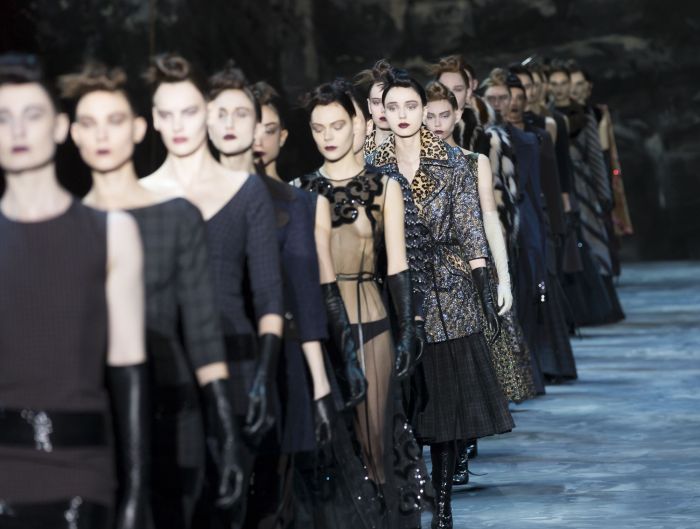
Marc Jacobs, Alexander McQueen and Hedi Slimane are some of the biggest names on the Fashion Week calendar, but that wasn’t always the case. Before they made a name for themselves in the industry, they all had a series of horribly failed collections that could have made their entire career come to a screeching halt. Some were just starting off and understandably green, while others were transitioning from one label to the next and still hadn’t managed to find their footing. Despite the scathing reviews and words of disappointment from fashion critics, these designers managed to overcome their failures and become some of the most successful names in fashion.

Marc Jacobs
Marc Jacobs was not always one of the biggest tickets on the NYFW circuit. Right out of school he was a promising designer: he won the Perry Ellis Gold Thimble Award and Design Student of the Year at graduation in 1984, was the youngest designer ever to win the CFDA Perry Ellis Award for New Fashion Talent, and won the 1992 CFDA prize for Womenswear Designer of the Year. In 1992, when he was designing for Perry Ellis, he created a grunge collection that sent Doc Marten boots, plaid shirts and dingy layers down the runway. It received such horrific reviews that he was immediately fired and as far as the industry was considered, he was finished. Shortly after Louis Vuitton approached him about working for their brand, where he was later named creative director of the label. LVMH also ended up funding his first store, rocketing him to fashion fame. Today he’s one of the world’s most celebrated designers.
Olivier Theyskens
Olivier Theyskens may not be a household name, but this Belgian designer has been influencing the trends from behind the scenes at big names like Nina Ricci, Rochas and Theory. One of his first major appointments as creative director of Rochas was met with great success, and during his time there he was given the Star Award by the Fashion Group International and the CFDA International Award. When he moved onto Nina Ricci, however, things didn’t run as smoothly. While his collections were enjoyed by those in the industry, customers were ambivalent and sales tanked. After a huge falling out and a very public firing, Anna Wintour wrote in an editor’s letter: “There's a reason we continue to see Theyskens' influence everywhere, from catwalks to the mall. He'll be back, but fashion must hold its nerve.” Theyskens did come back as the creative director of Theory, where he held the role until 2014 when he left (amicably) to pursue personal projects.

Hedi Slimane
Today, Hedi Slimane’s position at Saint Laurent feels as natural as pairing peanut butter and jelly. But when the designer was first appointed as creative director at YSL in 2012, critics were not happy. He and the Saint Laurent PR team had already made a huge fuss about dropping Yves from the name, so the press didn’t walk into Slimane’s debut with a particularly positive outlook. Maybe it was the name change—or maybe it was the California rock-inspired collection that felt too far removed from YSL's signature smoking jackets. Either way, when the reviews rolled in they were not good. Cathy Horyn of the NY Times noted she wasn’t even invited as press attendance had been cut (or important editors had been moved to the back seats) to make room for Slimane’s friends. “Considering that Mr. Slimane was an avatar of youthful style, I expected more from this debut,” Horyn wrote in her review. “But there wasn’t something new to learn here.” Slimane has since mended his relationship with the press and his collections are met with general excitement every season.
Alexander McQueen
Once upon a time, long before Alexander McQueen was king of Gothic beauty and darkness, he was creative director at Givenchy. In 1996, McQueen replaced John Galliano after he moved to Dior. Galliano’s work at Dior was hailed a success, while McQueen’s work was considered quite the opposite. His debut show, Givenchy’s 1997 couture collection, was a total disaster and his dramatic designs were a shock for the ultra-elite look of couture. Five weeks after his failed debut, which by then he had agreed was “crap,” he presented his eponymous collection in London. It was an instant success. He quickly became one of the most sought after designers in fashion, and even won the coveted Designer of the Year Award at the British Fashion Awards four times. After his death in 2010,
Kanye West
To Kanye West, everything he does is successful. Fashion critics would disagree however, especially after he debuted his first collection in Paris in 2011. Even before the reviews had come out he was already lamenting how as a rapper, he wouldn’t be taken seriously in the world of fashion. Maybe he knew his designs were terrible, because shortly after he was hit with a number of scathing reviews. “What was most confounding about Mr. West’s behavior, after years of obsessive study of the industry, was that he demonstrated very little understanding of how he might actually be perceived by retailers and editors who have a vast amount of experience at detecting utter nonsense,” NY Times critic Eric Wilson noted in his review. “The fact that he is a celebrity is the reason that so many high-level people are even paying attention to him.” His Yeezy line, which he premiered 2015, fared little better, but he’s been gaining traction ever since, garnering passable (not great) reviews. Don’t worry Kanye, if this doesn’t work out you always have a rap career to fall back on.









